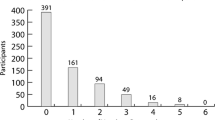Abstract
The Internet is an emerging research tool that may be useful for contacting and working with rural men who have sex with men (MSM). Little is known about HIV risks for rural men and Internet methodological issues are only beginning to be examined. Internet versus conventionally recruited samples have shown both similarities and differences in their demographic characteristics. In this study, rural MSM from three sizes of town were recruited by two methods: conventional (e.g. face-to-face/snowball) or Internet. After stratifying for size of city, demographic characteristics of the two groups were similar. Both groups had ready access to the Internet. Patterns of sexual risk were similar across the city sizes but varied by recruitment approach, with the Internet group presenting a somewhat higher HIV sexual risk profile. Overall, these findings suggest the Internet provides a useful and low cost approach to recruiting and assessing HIV sexual risks for rural White MSM. Further research is needed on methods for recruiting rural minority MSM.
Similar content being viewed by others
REFERENCES
Bailey, R. D., Foote, W. E., and Throckmorton, B. (2000). Human sexual behavior: A comparison of college and Internet surveys. In M. H. Birnbaum (Ed.), Psychological experiments on the Internet. San Diego: Academic Press.
Birnbaum, M. H. (2000). Decision making in the lab and on the Web. In M. H. Birnbaum (Ed.), Psychological experiments on the Internet (pp. 3–34). San Diego: Academic Press.
Bull, S., and MacFarlane, M. (2000). Soliciting sex on the Internet: What are the risks for sexually transmitted diseases and HIV? Sexually Transmitted Diseases, 27, 545–550.
Butler, M. A., and Beale, C. A. (1994). Rural–urban continuum codes for metropolitan and nonmetropolitan counties, 1993. Agriculture and Rural Economy Division, Economic Research Service, U.S. Department of Agriculture.
Heckman, T. G., Miller, J., Kochman, A., Kalichman, S. C., Carlson, B., and Silverthorn, M. (2002). Thoughts of suicide among HIV-Infected rural persons enrolled in a telephone-delivered mental health intervention. Annals of Behavioral Medicine, 24, 141–148.
Hudson, C. P. (1993). Concurrent partnerships could cause AIDS epidemics. International Journal of STD and AIDS, 4, 249–253.
Lam, N. S. N., and Liu, K. (1994). Spread of AIDS in rural America, 1982–1990. Journal of Acquired Immune Deficiency Syndromes, 7, 485–490.
Morris, M., and Kretzschmar, M. (1997). Concurrent partnerships and the spread of HIV. AIDS, 11, 641–648.
Office of Management and Budgets, Statistical Policy Office. (1995). OMB Bulletin, No. 95–04.
Rainie, L., and Packel, D. (2001). More online, doing more: 16 millions newcomers gain Internet access in the last half of 2000 as women, minorities, and families with modes incomes continue to surge online. Washington, DC: The Pew Internet and American Life Project.
Rhodes, S. D., DiClemente, R. J., Cecil, H., Hergenrather, K. C., and Yee, L. J. (2002). Risk among men who have sex with men in the United States: A comparison of an Internet sample and a conventional outreach sample. AIDS Education and Prevention, 14, 41–50.
Rickette, T. C., and Gesler, W. M. (1992). Health in rural North America. New Brunswck: Rutgers University Press.
Rickette, T. C., Savitz, L. A., Gesler, W. M., and Osborne, D. N. (1997). Using geographic methods to understand health issues. Washington, DC: DHHS, U.S. Public Health Service.
Ross, M., Tikkanen, R., and Mansson, S. (2000). Differences between Internet samples and conventional samples of men who have sex with men: Implications for research and HIV interventions. Social Science and Medicine, 47, 749–758.
Tikkanen, R., and Ross, M, W. (2000). Looking for sexual compatibility: Experiences among Swedish men in visiting Internet Gay Chat Rooms. CybrPsychology and Behavior, 3, 605–616.
Williams, M. W., Bowen, A. M., and Horvath, K. (in press). The social/sexual environment of gay men residing in a rural frontier state: Implications for the development of HIV prevention programs. Journal of Rural Health.
Author information
Authors and Affiliations
Rights and permissions
About this article
Cite this article
Bowen, A., Williams, M. & Horvath, K. Using the Internet to Recruit Rural MSM for HIV Risk Assessment: Sampling Issues. AIDS Behav 8, 311–319 (2004). https://doi.org/10.1023/B:AIBE.0000044078.43476.1f
Issue Date:
DOI: https://doi.org/10.1023/B:AIBE.0000044078.43476.1f




